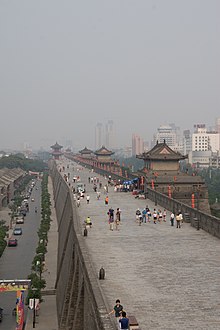Xi'an City Walls
The city wall of Xi'an ( Chinese 西安 城墙 , Pinyin Xī'ān chéngqiáng ) is the largest and most complete city wall in the People's Republic of China . Thanks to extensive renovation measures since the 1980s, the city wall can now be walked along its entire length and forms a rectangular ring around the old town of Xi'an (formerly Chang'an ).
description
The wall encloses an area of approx. 12 km². The walls in the north and south are about 3.5 kilometers long, the eastern and western sections about 2.5 kilometers. The structure of the walls is a walled earth wall, 12 meters high, 15 to 18 meters at the bottom and 12 to 14 meters wide at the top. There are a total of 5894 battlements on the outside of the wall . The moat outside the wall is still preserved in some places and filled with water.
The city wall has four large doors to each side of: The Anyuan Gate ( 安远门 ) to the north, the Changle Gate ( 长乐门 ) to the east, the Yongning Gate ( 永宁门 ) in the south and the Anding Gate ( 安定门 ) in the west. In addition to the original gates, 14 more have been added to improve the traffic situation in the city center. In addition to the 98 towers along the wall, three of the four corner towers have been preserved. In the past, these gates were reached via drawbridges , in the morning the gates were opened after a signal from the bell tower, in the evening the drawbridges were raised after a signal from the drum tower.
history
In the second year of the Sui dynasty (582), the Han dynasty (founded in 202 BC) began building a new capital of the Chinese at the place of today's Xi'an, a little southeast of the partly ruined capital Chang'an Empire began, whose name was initially Daxing (大興 城). In the following Tang Dynasty it was renamed Chang'an (長安) again.
The city consisted of the urban area with a total area of 77 km² within the city walls (8 km × 9.6 km). The government and palace area was again enclosed with its own walls.
At the beginning of the Ming Dynasty (1374-1378), the city wall that is preserved today was erected when the city was appointed the residence of the son of Emperor Hongwu . The walls of the old government area were partially (approx. 50%) reused. The city wall follows the old wall around the imperial palace and the administrative district in the southwest corner.
In the Ming dynasty, the wall and gate systems were improved and reinforced several times; under Emperor Qianlong of the Qing dynasty , a 20 meter wide and up to 7 meter deep moat was added in 1781.
At the beginning of the Republican era , some parts of the wall, including many of the towers, were torn down or fell into disrepair. During World War II , parts of the fortifications served as protection against Japanese air raids. After the founding of the People's Republic, the wall was interrupted in several places after 1949 in order to improve the traffic situation with new roads.
In 1961, the State Council of the People's Republic of China included the wall as one of the first objects on the list of monuments of the People's Republic of China . From 1983 a park was laid out along the wall and extensive work was carried out to restore the wall, so that the entire wall has been accessible again since 2005. Many tourists borrow bicycles for the 13.74 km long circuit to drive around the old town.

